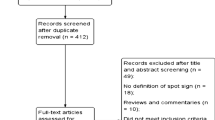Abstract
Purpose
This study aimed to comprehensively evaluate the diagnostic performance of dual-energy CT (DECT) for differentiating acute intracranial hemorrhage (ICH) from contrast staining or small calcifications via a systematic review and meta-analysis.
Methods
The PubMed–MEDLINE, EMBASE, and Cochrane Library databases were searched up to November 10, 2019. Original studies (prospective or retrospective cohort studies) with the primary aim of detecting ICH using DECT were selected. The diagnostic performance of DECT was assessed using bivariate and hierarchical summary receiver operating characteristic models. Quality assessment was performed according to the Quality Assessment of Diagnostic Accuracy Studies-2, while between-study heterogeneity was assessed using Higgins’ inconsistency index (I2). To explore heterogeneity, subgroup meta-regression analyses were performed. Deeks’ funnel plot asymmetry test was used for assessing publication bias.
Results
Nine studies comprising 402 patients with 453 lesions were included for data synthesis. The overall pooled sensitivity and specificity of DECT for ICH detection were 96% (95% CI, 77–99%) and 98% (95 CI, 93%–100%), respectively. Substantial and moderate between-study heterogeneities were observed for sensitivity (I2 = 90.3%) and specificity (I2 = 57.9%), respectively. In meta-regression analysis, type of cohort affected heterogeneity—studies including only stroke patients showed lower sensitivity (43.5% vs. 94.2%) but higher specificity (98.7% vs. 92.6%) than those with mixed etiologies (P < 0.001). Deeks’ funnel plot asymmetry test revealed publication bias (P = 0.020).
Conclusion
DECT demonstrated excellent diagnostic performance in terms of differentiating acute ICH from contrast staining and small calcifications. However, publication bias suggests the possibility of overestimated diagnostic performance, warranting large-scale, prospective cohort studies.





Similar content being viewed by others
Availability of data and material (data transparency)
Not applicable.
References
Parizel P, Makkat S, Van Miert E, Van Goethem J, van den Hauwe L, De Schepper A (2001) Intracranial hemorrhage: principles of CT and MRI interpretation. Eur Radiol 11(9):1770–1783. https://doi.org/10.1007/s003300000800
Payabvash S, Qureshi MH, Khan SM, Khan M, Majidi S, Pawar S, Qureshi AI (2014) Differentiating intraparenchymal hemorrhage from contrast extravasation on post-procedural noncontrast CT scan in acute ischemic stroke patients undergoing endovascular treatment. Neuroradiology 56(9):737–744. https://doi.org/10.1007/s00234-014-1381-8
Renú A, Amaro S, Laredo C, Román LS, Llull L, Lopez A, Urra X, Blasco J, Oleaga L, Chamorro Á (2015) Relevance of blood–brain barrier disruption after endovascular treatment of ischemic stroke: dual-energy computed tomographic study. Stroke 46(3):673–679
Fiorelli M, Bastianello S, von Kummer RD, Del Zoppo GJ, Larrue V, Lesaffre E, Ringleb AP, Lorenzano S, Manelfe C, Bozzao L (1999) Hemorrhagic transformation within 36 hours of a cerebral infarct: relationships with early clinical deterioration and 3-month outcome in the European Cooperative Acute Stroke Study I (ECASS I) cohort. Stroke 30(11):2280–2284
Khatri P, Wechsler LR, Broderick JP (2007) Intracranial hemorrhage associated with revascularization therapies. Stroke 38(2):431–440
Nute JL, Le Roux L, Chandler AG, Baladandayuthapani V, Schellingerhout D, Cody DD (2015) Differentiation of low-attenuation intracranial hemorrhage and calcification using dual-energy computed tomography in a phantom system. Investig Radiol 50(1):9–16
Makariou E, Patsalides AD (2009) Intracranial calcifications. Appl Radiol 38(11):48
Chen W, Zhu W, Kovanlikaya I, Kovanlikaya A, Liu T, Wang S, Salustri C, Wang Y (2014) Intracranial calcifications and hemorrhages: characterization with quantitative susceptibility mapping. Radiology 270(2):496–505
Morhard D, Ertl L, Gerdsmeier-Petz W, Ertl-Wagner B, Schulte-Altedorneburg G (2013) Dual-energy CT immediately after endovascular stroke intervention: prognostic implications. Cardiovasc Intervent Radiol 37:1–8. https://doi.org/10.1007/s00270-013-0804-y
Tijssen MP, Hofman PA, Stadler AA, van Zwam W, de Graaf R, van Oostenbrugge RJ, Klotz E, Wildberger JE, Postma AA (2014) The role of dual energy CT in differentiating between brain haemorrhage and contrast medium after mechanical revascularisation in acute ischaemic stroke. Eur Radiol 24(4):834–840. https://doi.org/10.1007/s00330-013-3073-x
Bonatti M, Lombardo F, Zamboni GA, Vittadello F, Curro Dossi R, Bonetti B, Pozzi Mucelli R, Bonatti G (2018) Iodine extravasation quantification on dual-energy CT of the brain performed after mechanical thrombectomy for acute ischemic stroke can predict hemorrhagic complications. AJNR Am J Neuroradiol 39(3):441–447. https://doi.org/10.3174/ajnr.A5513
Gupta R, Phan CM, Leidecker C, Brady TJ, Hirsch JA, Nogueira RG, Yoo AJ (2010) Evaluation of dual-energy CT for differentiating intracerebral hemorrhage from iodinated contrast material staining. Radiology 257(1):205–211. https://doi.org/10.1148/radiol.10091806
Phan CM, Yoo AJ, Hirsch JA, Nogueira RG, Gupta R (2012) Differentiation of hemorrhage from iodinated contrast in different intracranial compartments using dual-energy head CT. AJNR Am J Neuroradiol 33(6):1088–1094. https://doi.org/10.3174/ajnr.A2909
Watanabe Y, Tsukabe A, Kunitomi Y, Nishizawa M, Arisawa A, Tanaka H, Yoshiya K, Shimazu T, Tomiyama N (2014) Dual-energy CT for detection of contrast enhancement or leakage within high-density haematomas in patients with intracranial haemorrhage. Neuroradiology 56(4):291–295. https://doi.org/10.1007/s00234-014-1333-3
Bodanapally UK, Dreizin D, Issa G, Archer-Arroyo KL, Sudini K, Fleiter TR (2017) Dual-energy CT in enhancing subdural effusions that masquerade as subdural hematomas: diagnosis with virtual high-monochromatic (190-keV) images. AJNR Am J Neuroradiol 38(10):1946–1952. https://doi.org/10.3174/ajnr.A5318
Wiggins WF, Potter CA, Sodickson AD (2019) Dual-energy CT to differentiate small foci of intracranial hemorrhage from calcium. Radiology 190792. https://doi.org/10.1148/radiol.2019190792
Hu R, Besheli LD, Young J, Wu M, Pomerantz S, Lev MH, Gupta R (2016) Dual-energy head CT enables accurate distinction of intraparenchymal hemorrhage from calcification in emergency department patients. Radiology 280(1):177–183. https://doi.org/10.1148/radiol.2015150877
Johnson TR (2012) Dual-energy CT: general principles. Am J Roentgenol 199(5_supplement):S3–S8
Liberati A, Altman DG, Tetzlaff J, Mulrow C, Gotzsche PC, Ioannidis JP, Clarke M, Devereaux PJ, Kleijnen J, Moher D (2009) The PRISMA statement for reporting systematic reviews and meta-analyses of studies that evaluate health care interventions: explanation and elaboration. Ann Intern Med 151(4):W65–W94. https://doi.org/10.7326/0003-4819-151-4-200908180-00136
Whiting PF, Rutjes AW, Westwood ME, Mallett S, Deeks JJ, Reitsma JB, Leeflang MM, Sterne JA, Bossuyt PM (2011) QUADAS-2: a revised tool for the quality assessment of diagnostic accuracy studies. Ann Intern Med 155(8):529–536
Higgins J (2011) Cochrane handbook for systematic reviews of interventions. Version 5.1. 0 [updated March 2011]. The Cochrane Collaboration. www.cochrane-handbook.org
Devillé WL, Buntinx F, Bouter LM, Montori VM, De Vet HC, Van der Windt DA, Bezemer PD (2002) Conducting systematic reviews of diagnostic studies: didactic guidelines. BMC Med Res Methodol 2(1):9
Deeks JJ, Macaskill P, Irwig L (2005) The performance of tests of publication bias and other sample size effects in systematic reviews of diagnostic test accuracy was assessed. J Clin Epidemiol 58(9):882–893
Ebashi R, Ogata A, Nishihara M, Inoue K, Yoshioka F, Takase Y, Masuoka J, Yakushiji Y, Irie H, Hara H, Abe T (2019) Significance of simulated conventional images on dual energy CT after endovascular treatment for ischemic stroke. J NeuroInterv Surg 11(9):898–902. https://doi.org/10.1136/neurintsurg-2018-014486
Paciaroni M, Agnelli G, Corea F, Ageno W, Alberti A, Lanari A, Caso V, Micheli S, Bertolani L, Venti M (2008) Early hemorrhagic transformation of brain infarction: rate, predictive factors, and influence on clinical outcome: results of a prospective multicenter study. Stroke 39(8):2249–2256
Gn S, Cangür H, Albers T, Burgemeister A, Meyer-Wiethe K (2009) Sonographic evaluation of hemorrhagic transformation and arterial recanalization in acute hemispheric ischemic stroke. Stroke 40(1):119–123
Hamann GF, del Zoppo GJ, von Kummer R (1999) Hemorrhagic transformation of cerebral infarction–possible mechanisms. Thromb Haemost 82(S 01):92–94
Funding
No funding was received for this study.
Author information
Authors and Affiliations
Corresponding author
Ethics declarations
Conflict of interest
The authors declare that they have no conflict of interest.
Ethics approval
This is a retrospective literature review study. Our institutional review board (IRB) has confirmed that no ethical approval is required (IRB No. KC19ZISI0865).
Consent to participate
Written informed consent was not required for this study because it is a meta-analysis based on studies that have already been published.
Consent for publication
Written informed consent was not required for this study because it is a meta-analysis based on studies that have already been published.
Code availability (software application or custom code)
Not applicable.
Additional information
Publisher’s note
Springer Nature remains neutral with regard to jurisdictional claims in published maps and institutional affiliations.
Rights and permissions
About this article
Cite this article
Choi, Y., Shin, NY., Jang, J. et al. Dual-energy CT for differentiating acute intracranial hemorrhage from contrast staining or calcification: a meta-analysis. Neuroradiology 62, 1617–1626 (2020). https://doi.org/10.1007/s00234-020-02486-w
Received:
Accepted:
Published:
Issue Date:
DOI: https://doi.org/10.1007/s00234-020-02486-w




